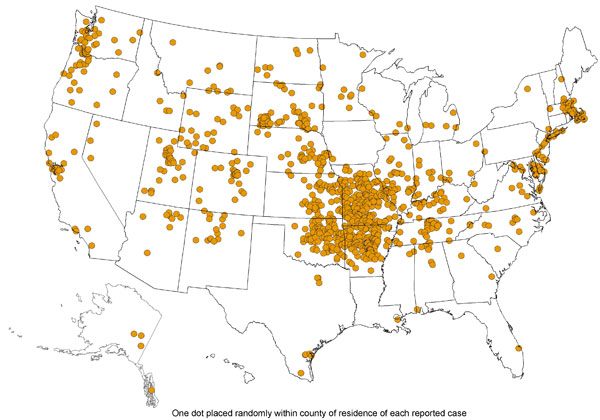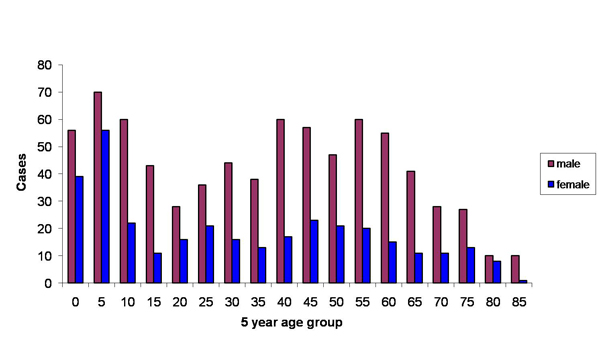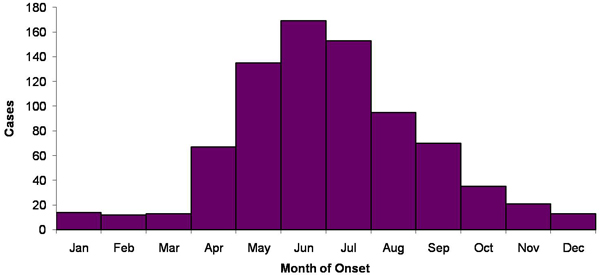Tularemia
Original Editors - Dana Collins from Bellarmine University's Pathophysiology of Complex Patient Problems project.
Lead Editors - Your name will be added here if you are a lead editor on this page. Read more.
Definition/Description[edit | edit source]
Tularemia, named after the infectious gram-negative bacterium Francisella tularensis, is a zoonotic disease. A zoonotic disease is one that is spread from animal to human. This spread may be directly i.e. handling contaminated meat or through a carrier i.e. a tick. It is also known as “Ohara’s disease”, “rabbit fever”, “deer-fly fever”,[1] “market’s men disease”, “meat-cutter’s disease”, “glandular type of tick fever”, “water rat-trappers’ disease”. It is highly infectious, <10 organisms causing severe disease in both humans and animals.[2] There are 4 sub-types of the bacterium, the most common in the United States are Type A, tularenis, and Type B, holarctica. It is on the Center for Disease Control’s list of bioterroism threats.
http://www.youtube.com/watch?feature=player_detailpage&v=zUVQB39ATME
Prevalence[edit | edit source]
The prevalence of Tularemia in the United States depends on the geographical location and the time of year. During the spring and summer months (May-September), there is a rise in reported cases. South-Central, Pacific Northwest, and parts of the East Coast have the highest incidence of Tularemia. While the population most effected is young males 5-9 years old and those > 75 years old.[3]
The above images from: http://www.cdc.gov/tularemia/statistics/.
Characteristics/Clinical Presentation[edit | edit source]
add text here
Associated Co-morbidities[edit | edit source]
add text here
Medications[4][edit | edit source]
Antibiotic therapy is used to treat Tularemia. Streptomyocin and Gentamicin are usually the first administered. Ciprofloxacin along with other fluoroquinolones. Tetracycline and chloramphenicol may also be used to treat Tularemia, however they have higher relapse rates than the previously mentioned.
Resistant to beta-lactam antibiotics and azithromycin.
Diagnostic Tests/Lab Tests/Lab Values[4][edit | edit source]
There are numerous ways to test for F. tularensis:
• Gold Standard: Bacteriologic Culture[2]
• Most Common: Serology[2]
• PCR of sample ulcer
• Direct Stains
• Blood Culture
• Direct Fluorescent Antibody Stain
• Slide Agglutination
• Antimicrobial Susceptibility
• Biochemical Identification
• Enviornmental Specimen Evaluation
• Chest X-ray
Etiology/Causes [2][edit | edit source]
Direct transmission occurs from direct contact with the infected animal or direct contact from soil, water, or landscape. This may be from ingestion of contaminated meat (most likely rabbit), water, or inhaled dust. It can also be passed from handling or skinning contaminated animals or from a bite/scrath from a contaminated animal. Animal hosts that may spread Tularemia include lagomorphs (rabbit and hare), rodents, insectivores, carnivores, ungulates, marsupials, birds, amphibians, fish, and invertebrates. Secondary carriers include ticks, mosquitoes, biting flies or deerfly. With such a wide variety of hosts and carriers available of this disease, it is has the possibility to appear/outbreak in other regions.
Systemic Involvement[edit | edit source]
add text here
Medical Management (current best evidence)[edit | edit source]
add text here
Physical Therapy Management (current best evidence)[edit | edit source]
Currently did not come across any management in reagards to physical therapy.
Alternative/Holistic Management (current best evidence)[edit | edit source]
The only reported treatments for Tularemia in the literature was through antibiotics. (See above section: Medications)
Differential Diagnosis[edit | edit source]
add text here
Case Reports/ Case Studies[edit | edit source]
Isolation of Francisella tularensis from blood.[5]
Tularemia: Emergency department presentation of an infrequently recognized disease. http://www.sciencedirect.com/science?_ob=ArticleURL&_udi=B6W9K-4C4FJTF-GS&_user=10&_coverDate=09%2F30%2F1985&_rdoc=1&_fmt=high&_orig=gateway&_origin=gateway&_sort=d&_docanchor=&view=c&_rerunOrigin=google&_acct=C000050221&_version=1&_urlVersion=0&_userid=10&md5=8437c09158b0597f13c1896c220c972e&searchtype=a
Treatment of tularemia with fluoroquinolones: two cases and review. http://www.ncbi.nlm.nih.gov/pubmed/10589911
Resources
[edit | edit source]
add appropriate resources here
Recent Related Research (from Pubmed)[edit | edit source]
see tutorial on Adding PubMed Feed
Failed to load RSS feed from http://http://eutils.ncbi.nlm.nih.gov/entrez/eutils/erss.cgi?rss_guid=1xy-1_DjTDyg-yCxbAyHc37zdTAK3fTd5nhb8khoKmGON3zYjN|charset=UTF-8|short|max=10: Error parsing XML for RSS
References[edit | edit source]
see adding references tutorial.
- ↑ Wilson M, Lountzis N, Ferringer T. Zoonoses of dermatologic interest. Dermatologic Therapy. 2009;22:367-378. http://onlinelibrary.wiley.com/doi/10.1111/j.1529-8019.2009.01248.x/abstract. Accessed February 2011.
- ↑ 2.0 2.1 2.2 2.3 Cite error: Invalid
<ref>tag; no text was provided for refs namedF - ↑ Hayes E, Marshall S, Dennis D. Tualremia--United States,1990-2000. www.cdc.gov/mmwr/preview/mmwrhtml/mm5109a1.htm. February 20, 2011.
- ↑ 4.0 4.1 CIDRAP. Tularemia: Current, comprehensive information on pathogenesis, microbiology, epidemiology, diagnosis, treatment, and prophylaxis. http://www.cidrap.umn.edu/cidrap/content/bt/tularemia/biofacts/tularemiafactsheet.html. Updated March 16, 2010. Accessed February 2011.
- ↑ Provenza JM, Klotz SA, Penn RL. Isolation of francisella tularenis from blood. Journal of Clinical Microbiology. 1986;24:453-455. http://jcm.asm.org/cgi/content/short/24/3/453. Accessed February 2011.









